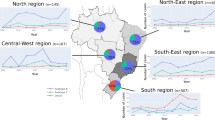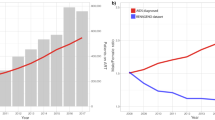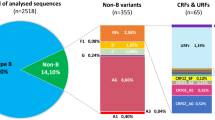Abstract
To develop an HIV-1 vaccine with global efficacy, it is important to identify and characterize the viruses that are transmitted, particularly to individuals living in areas of high incidence. Several studies have shown that virus from the blood of acutely infected adults was homogeneous, even when the virus population in the index case was genetically diverse1,2,3,4. In contrast to those results with mainly male cohorts in America and Europe, in several cases a heterogeneous virus population has been found early in infection in women in Africa5,6. Thus, we more closely compared the diversity of transmitted HIV-1 in men and women who became infected through heterosexual contact. We found that women from Kenya were often infected by multiple virus variants, whereas men from Kenya were not. Moreover, a heterogeneous virus was present in the women before their seroconversion, and in each woman it was derived from a single index case, indicating that diversity was most likely to be the result of transmission of multiple variants. Our data indicate that there are important differences in the transmitted virus populations in women and men, even when cohorts from the same geographic region who are infected with the same subtypes of HIV-1 are compared.
This is a preview of subscription content, access via your institution
Access options
Subscribe to this journal
Receive 12 print issues and online access
$209.00 per year
only $17.42 per issue
Buy this article
- Purchase on SpringerLink
- Instant access to full article PDF
Prices may be subject to local taxes which are calculated during checkout



Similar content being viewed by others
References
Wolfs, T.F., Zwart, G., Bakker, M. & Goudsmit, J. HIV-1 genomic RNA diversification following sexual and parenteral virus transmission. Virology 189, 103–110 ( 1992).
Zhu, T. et al. Genotypic and phenotypic characterization of HIV-1 in patients with primary infection. Science 261, 1179 –1181 (1993).
Zhang, L.Q. et al. Selection for specific sequences in the external envelope protein of human immunodeficiency virus type 1 upon primary infection. J. Virol. 67, 3345–3356 (1993).
McNearney, T. et al. Relationship of human immunodeficiency virus type 1 sequence heterogeneity to stage of disease. Proc. Natl. Acad. Sci. USA 89, 10247–10251 (1992).
Kampinga, G.A. et al. Primary infections with HIV-1 of women and their offspring in Rwanda: findings of heterogeneity at seroconversion, coinfection, and recombinants of HIV-1 subtypes A and C. Virology 227, 63–76 (1997).
Poss, M. et al. Diversity in virus populations from genital secretions and peripheral blood from women recently infected with human immunodeficiency virus type 1. J. Virol. 69, 8118–8122 (1995).
Rakwar, J. et al. Cofactors for the acquisition of HIV-1 among heterosexual men: Prospective cohort study of trucking company workers in Kenya. AIDS 13, 607–614 ( 1999).
Miedema, F. et al. Changing virus-host interactions in the course of HIV-1 infection . Immunol. Rev. 140, 35– 72 (1994).
Delwart, E.L., Sheppard, H.W., Walker, B.D., Goudsmit, J. & Mullins, J.I. Human immunodeficiency virus type 1 evolution in vivo tracked by DNA heteroduplex mobility assays. J. Virol. 68, 6672–6683 (1994).
Martin, H. L. et al. Hormonal contraception, sexually transmitted diseases, and the risk of heterosexual transmission of HIV-1. J. Infect. Dis. 178, 1053–1059 ( 1998).
Neilson, J. et al. Subtypes of HIV-1 and disease stage among women in Nairobi, Kenya. J. Virol. 73, 4393– 4403 (1999).
Karlsson, A.C., Lindback, S., Gaines, H. & Sonnerborg, A. Characterization of the viral population during primary HIV-1 infection. AIDS 12, 839–847 (1998).
Wolinsky, S.M. et al. Selective transmission of human immunodeficiency virus type-1 variants from mothers to infants. Science 255, 1134–1137 (1992).
Mertens, T.E. & Burton, A. Estimates and trends of the HIV/AIDS epidemic. AIDS 10, S221– S228 (1996).
Busch, M.P. et al. Time course of detection of viral and serologic markers preceding human immunodeficiency virus type 1 seroconversion: implications for screening of blood and tissue donors. Transfusion 35, 91–97 (1995).
Overbaugh, J., Anderson, R.J., Ndinya-Achola, J.O. & Kreiss, J.K. Distinct but related human immunodeficiency virus type 1 variant populations in genital secretions and blood. AIDS Res. Hum. Retroviruses 12, 107–115 (1996).
Hajjar, A.M., Lewis, P. F., Endeshaw, Y., Ndinya-Achola, J., Kreiss, J. K., Overbaugh, J. Efficient HIV-1 RNA isolation from cervical swabs. J. Clin. Microbiol. 2349–2352 ( 1997).
Delwart, E.L., Herring, B., Rodrigo, A.G. & Mullins, J.I. Genetic subtyping of human immunodeficiency virus using a heteroduplex mobility assay. PCR Methods Appl. 4, S202– S216 (1995).
Swofford, D.L. PAUP*, Phylogenetic Analysis Using Parsimony (*and Other Methods) Version 4. (Sinauer Associates, Sunderland, Massachusetts, 1999).
Acknowledgements
We thank D. D. Panteleeff, M. Poss, R. Anderson, J. Neilson, J. Gosink and B. Chohan for technical assistance; B. Richardson for assistance with statistical analysis and discussions; J. Carr for advice on computational analyses; and J. Bwayo, J. Ndinya-Achola and the Nairobi HIV/STD Research Project for the continued collaborations and interactions that make this research possible. We also thank C. Giachetti, S. Bodrug and M. Bott of Gen-Probe for assistance with the HIV-1 RNA assay. This work was supported by the National Institutes of Health through grants AI38518 and AI33873 and through Family Health International subcontract N01-AI35173-119. E.M.L. was supported in part by National Institutes of Health predoctoral fellowship T32 GM07270.
Author information
Authors and Affiliations
Corresponding author
Rights and permissions
About this article
Cite this article
Michelle Long, E., Martin, H., Kreiss, J. et al. Gender differences in HIV-1 diversity at time of infection. Nat Med 6, 71–75 (2000). https://doi.org/10.1038/71563
Received:
Accepted:
Issue Date:
DOI: https://doi.org/10.1038/71563



